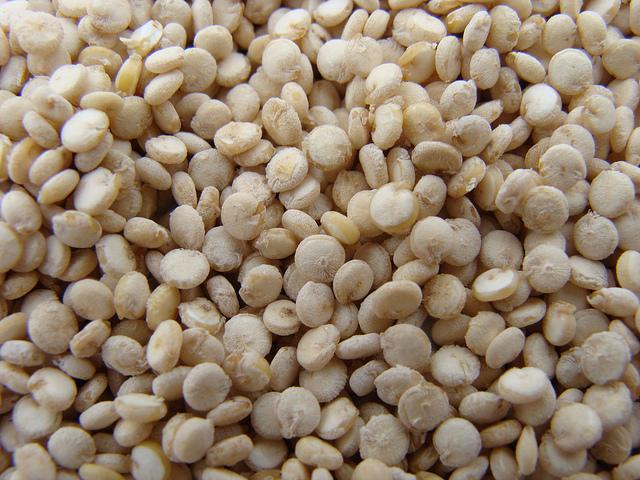Bhutan scales up quinoa diet to tackle rising cases of noncommunicable diseases

April 16, 2025
THIMPHU – Students of Wangbama School in Thimphu and Bartsham Central School in Trashigang will now receive, quinoa supplement in food diet along with rice with plans to replicate the programme in selected hospitals. The broader plan is to diversify the initiative nationwide.
This follows a study carried out at the National Referral Hospital (JDWNRH) starting August last year with the use of quinoa in the in-patient diet. Sourced directly from the farmers in the East, milled and supplied with support from Agriculture Research and Development Centre at Wengkhar, Mongar, and the National Centre for Organic Agriculture at Yusipang in Thimphu under the Department of Agriculture, the Department of Agricultural Marketing and Co-operatives (DAMC) initiated the trial of quinoa as a nutrient-dense alternative in collaboration with the Management of JDWNRH and the Ministry of Health.
According to a report Use of Quinoa In The In-Patient Diet by the Nutrition and Diet Services Department, JDWNRH supported by One Country, One Priority Product initiative of the Food and Agriculture Organization (FAO) of the UN, high rice intake in the country, along with urban lifestyles, has contributed to rising cases of obesity, diabetes, and high blood pressure over the years.
To address these growing challenges, JDWNRH has been piloting the use of quinoa in the in-patient diet which ends in June this year—supplying 3.6 metric tonnes (MT) of quinoa as a rice substitute.
The addition of quinoa to the diet has reduced rice consumption by 2,000 kilograms (kg) with a 10 percent quinoa substitution in hospital meals.
Quinoa, a climate-resilient crop introduced in 2015, presents a viable alternative due to its superior nutritional profile, including a low glycemic index (glucose), high protein content supporting muscle maintenance and recovery, rich fibre content aiding digestive health, high levels of essential minerals like magnesium, iron, zinc, and vitamin B.
The OCOP Program Focal Official at DAMC said that the Department has been stressing on marketing aspects, linking farmers with the institutions, and enhancing market acceptance through free distributions.
The Department of Agriculture has identified 14 dzongkhags and is prioritising quinoa scale-up programmes in these Dzongkhags.
The cooks working at JDWNRH and the two pilot schools have also been trained on quinoa and rice mixing as well as preparation.
While rice has been a dietary staple in Bhutan for centuries, its excessive consumption has resulted in rising prevalence of non-communicable diseases, as evidenced by national health reports. Urbanisation and sedentary lifestyles have further exacerbated these health concerns.
According to reports from the health ministry, 42.2 percent of men and 49.2 percent of women are overweight. About 13 percent of adults are receiving treatment for elevated blood sugar levels. Moreover, the National Health Survey states that 32.4 percent of men and 27.6 percent of women have elevated blood pressure.
To reduce rice consumption and introduce dietary diversity, the Nutritionists at JDWNRH assessed quinoa’s health benefits for patients with diabetes and metabolic disorders. Moreover, promotion of local quinoa production and educating patients on quinoa’s nutritional value were targeted.
The study, which assessed over 100 in-patients, patients, and caregivers stated that 72.5 percent of the patients consumed hospital meals during their stay, while 27.5 percent of them always relied on hospital meals.
The majority of patients, 70 percent, reported preferring hospital meals over home-based meals. “Among the patients, 58 percent had prior knowledge about quinoa, 40 percent had eaten it before, while 42 percent of them were introduced to quinoa at the National Referral Hospital,” the study pointed out.
At the national level, if quinoa substitution is scaled across all hospitals, potential benefits include a 30,000kg annual reduction in rice consumption, a 5 to 7 percent decrease in rice imports, and lower healthcare costs related to excessive carbohydrate intake and protein deficiency, according to the report.
Currently, schools across the country consume an average of 6,921 MT of rice annually, amounting to Nu 291 million.
As per the study, patients consuming quinoa as a complete rice replacement at the hospital reported health improvements such as improved blood glucose control, enhanced digestion, improved blood sugar levels, and chose to continue quinoa consumption even after discharge from the hospital.
JDWNRH’s quinoa initiative reportedly has reduced rice consumption by 2,000kg in six months—which translates to a reduction in rice import costs by Nu 184.326 million per year.
“Quinoa integration in diet would enhance food security by reducing dependence on rice imports, support local farming, and help prevent chronic diseases through the fiber-rich content in quinoa,” the focal official from DAMC said.
However, he said that the cost has remained a major barrier to wider adoption as quinoa has just picked up in the market. “Cultural preferences for rice and limited awareness about quinoa’s benefits and preparation methods have impacted its wide-scale consumption.”
At the market price, quinoa fetches between Nu 150 and 250 per kg.
The study recommends the expansion of quinoa adoption in hospitals and schools to promote healthier eating.
The study also recommended measures such as subsidising quinoa to make it more affordable, support through local farming and training programmes to ensure a stable supply, diversification of recipes to improve taste acceptance, and enhancing education.
According to records with the FAO, although quinoa grows in 18 dzongkhags, seven dzongkhags, namely Samtse, Dagana, Samdrupjongkhar, Zhemgang, Trongsa, Trashiyangtse, and Wangdue are best suited to grow the crop.
The FAO as the technical lead targets producing 2,360 MT of quinoa a year which can benefit over 4,000 households. It plans to invest USD 7.94 million in production and processing of the crop.
Funded by the FAO’s Flexible Voluntary Contribution (FVC), the global project will end this year with a funding of USD 500,000.
Bhutan has also established growing quinoa as one of the key National Commodity Programmes to harness its multi-dimensional benefits—focussing on four areas: stakeholder engagement through capacity building and technical processing, Geographical Indication (GI) to improve legislative framework development and Geographical Indication Environmental Sustainability (GIES) which would promote the unique value of the product considering environmental aspects.
The MoAL has targeted to enhance quinoa production to 250 MT by 2029 from its baseline of 12.88 MT in 2023.
Additionally, the ministry has initiated a project titled “Scaling the Implementation of OCOP Initiative” which aims to bolster value-chain-based markets to elevate income levels, promote gender-responsive rural livelihoods, and generate employment opportunities.
This initiative is backed by a funding of USD 1 million in the region.
link





